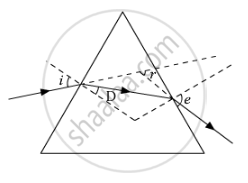Advertisements
Advertisements
प्रश्न
What is dispersion? Explain in detail.
उत्तर
- Splitting white light into its seven constituent colours (wavelength), on passing through a transparent medium is known as dispersion of light.
- Dispersion occurs because the light of different colours present in white light have different wavelength and they travel at different speeds in a medium.
- The refraction of a light ray in a medium depends on its speed.
APPEARS IN
संबंधित प्रश्न
After tracing the path of a ray of light through a glass prism a student marked the angle of incidence (∠i), angle of refraction (∠r) angle of emergence (∠e) and the angle of deviation (∠D) as shown in the diagram. The correctly marked angles are :

(A) ∠i and ∠r
(B) ∠i and ∠e
(C) ∠i, ∠e and ∠D
(D) ∠i, ∠r and ∠e
State the cause of dispersion of white light
What happens when a ray of ordinary light is passed through a triangular glass prism?
What will happen if another similar glass prism is placed upside down behind the first prism?
In the figure given alongside, a narrow beam of white light is shown to pass through a triangular glass prism. After passing through the prism, it produces a spectrum YX on the screen.
Why do different colours of white light bend through different angles with respect to the incident beam of light?
A beam of white light is shone onto a glass prism. The light cannot be:
(a) deviated
(b) dispersed
(c) focused
(d) refracted
Out of air and glass, which is optically rarer? Give reason.
Complete the ray diagram given below to show the nature of light produced on the screen.

When a white light ray falls on a prism, the ray at its first surface suffers ______.
Draw a labeled ray diagram to illustrate the dispersion of a narrow beam of white light when it passes through a glass prism.
